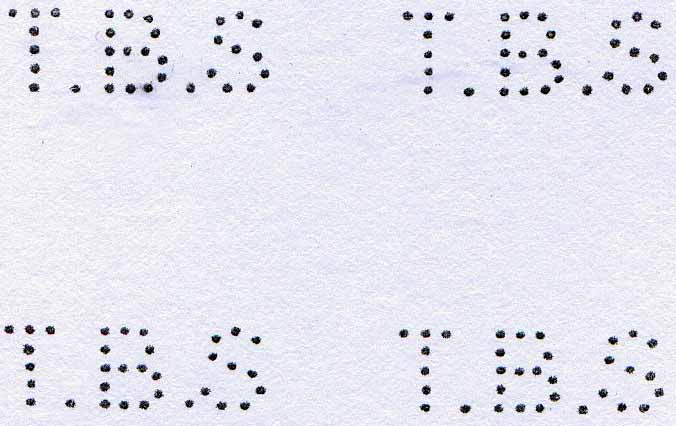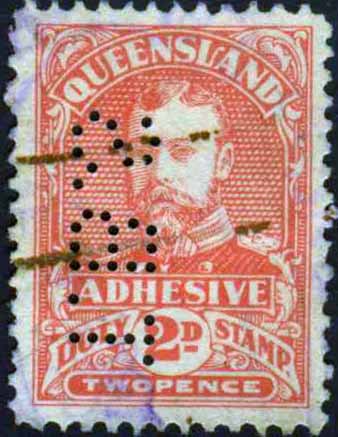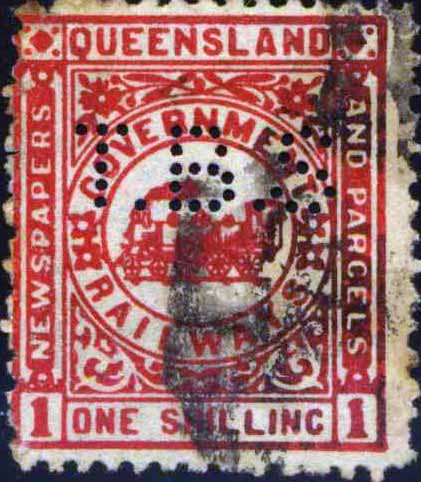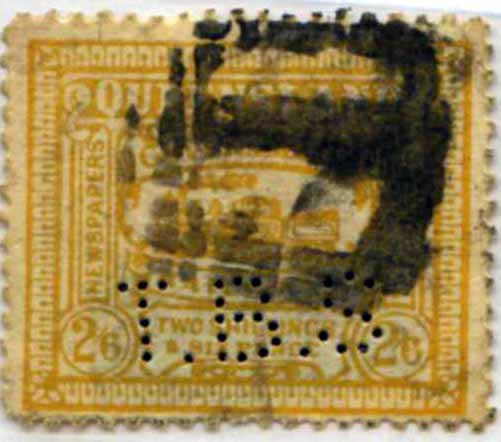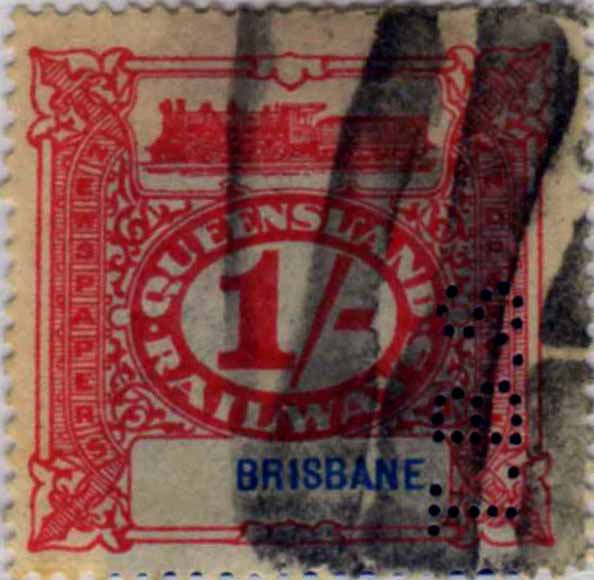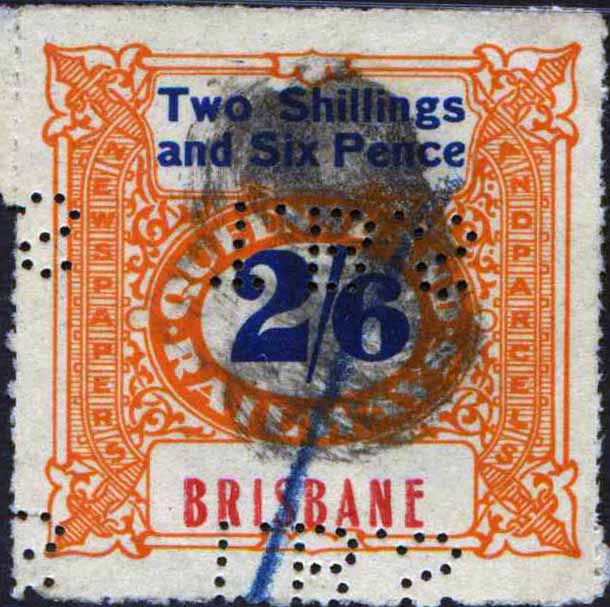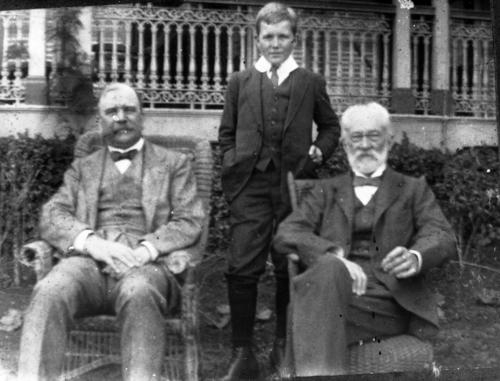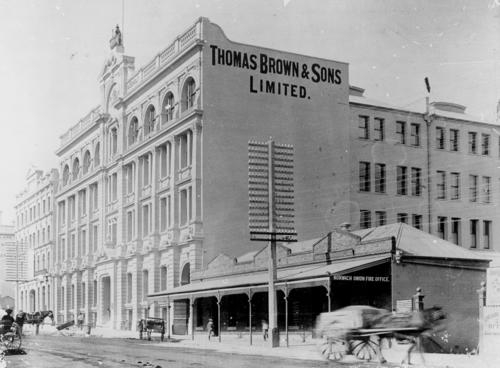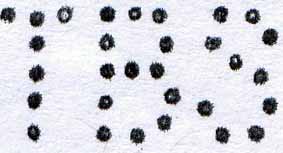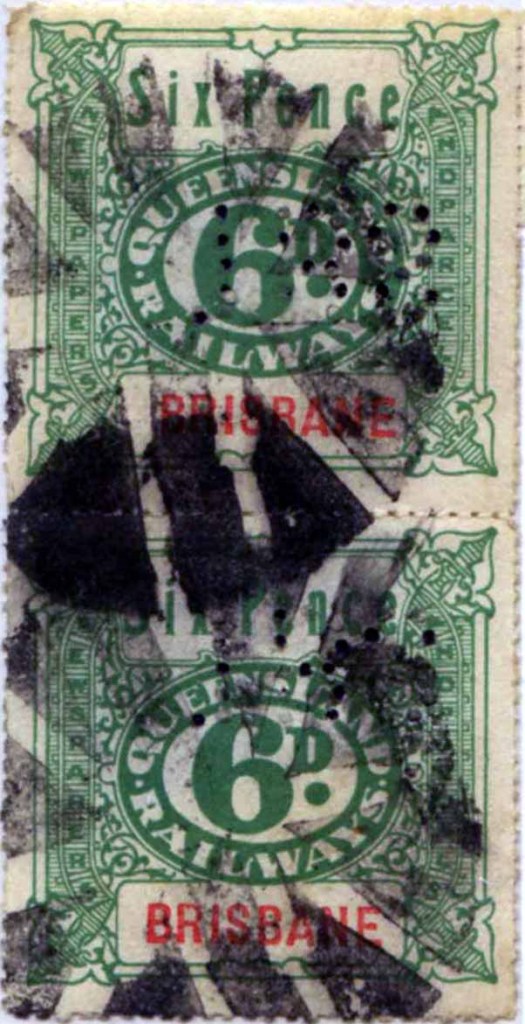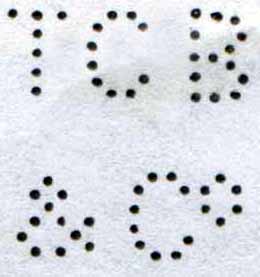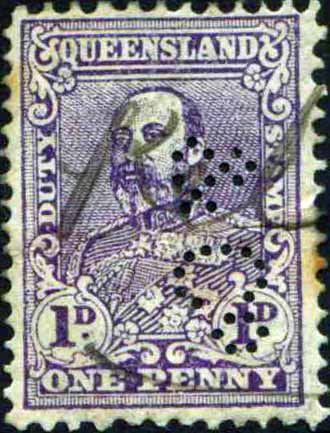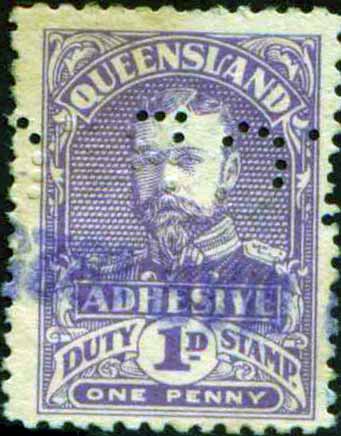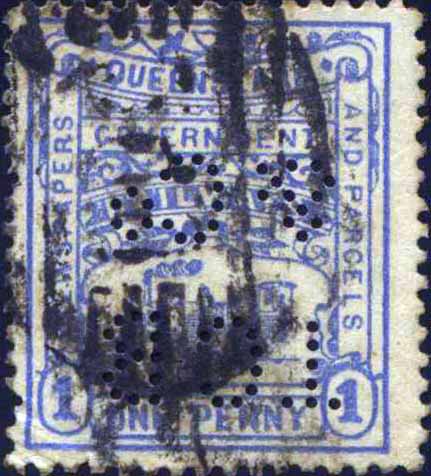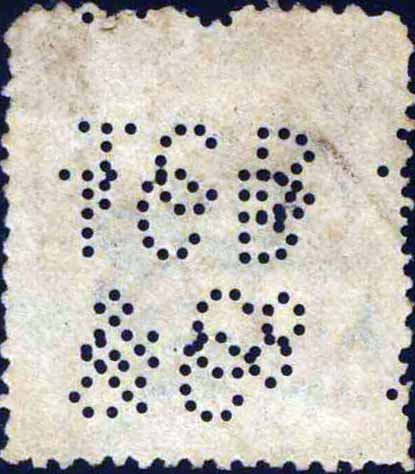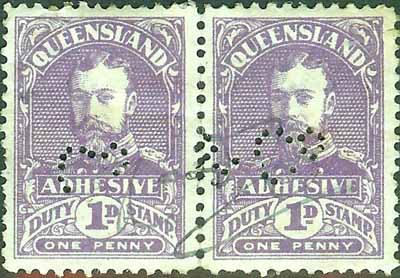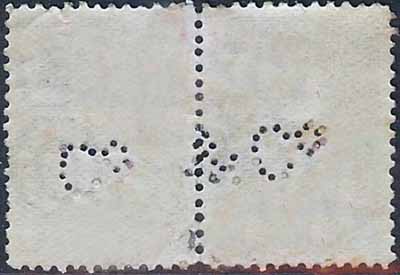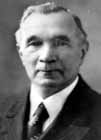|
Private Revenue Perfins of Queensland An Elsmore Coath production The authors would welcome your comments additions or input into this work
T -------------------------------------------------------- T.B.S.a 4 head device Die I Die II Die III Die IV Thomas Brown with son, T.S.G. Brown, and Sir Samuel Walker Griffith on the right Picture State Library Queensland Thomas Brown & Sons building on Eagle Street, Brisbane, circa 1898. Picture State Library Queensland User: Thomas Brown & Sons Drapers, later Distillers, Milliners and Retailers Address: Eagle St, Brisbane, QLD Revenue Use: KEDVII 1901 issue 1d, 1/-. KGV 1926 issue, 1d, 2d, 3d, 6d. Numeral 1d, 2d. Rarity Scale: KEDVII 1901 issue 1d R4, 1/- R4. KGV 1926 issue 1d R3, 2d R3, 3d R3, 6d R3. Numeral 1d R4, 2d R4. Railway Use: 1902 issue 3d, 6d, 1/-, 2/6d, 5/-. 1915 issue 1d, 3d, 6/- 1/-. 1919 roulette issue 3d. 1927 numeral issue 1d, 3d, 5d, 6d, 1/-, 2/6d, 5/-. Rarity Scale: 1902 issue 3d R4, 6d R4, 1/- R3, 2/6d R4, 5/- R4. 1915 issue 1d R4, 3d R4, 6d R4, 1/- R4. 1919 roulette issue 3d R4. 1927 numeral issue 1d R4, 3d R4, 5d R4, 6d R4, 1/- R4, 2/6d R4, 5/- R4. Background: *David Brown was born
in Scotland in 1839 and trained in the
soft-goods business. In 1862 his elder brother
Thomas, who had founded a drapery in Glasgow, sent
David to start a branch of the business in
Brisbane. This business was named D L Brown and
Co.. Despite major losses in the 1863
and 1893 floods and a devastating fire in 1888 the
Browns built up a large and successful
distribution business. They increased their range
of imports and expanded their distribution by
purchasing ships to deliver to the Tweed River
district and the South Sea Islands. D L Brown and
Co had a private wharf at the main warehouse in
Eagle Street and in 1877 they purchased wharfage
facilities in Short Street which it expanded into
a major overseas terminal. In 1888 the Eagle
Street warehouse was totally destroyed but a new
ornate building was built to replace it. In the late 1880s Thomas sent out
his own two sons, John and Thomas (jnr) to
Brisbane and in 1889 D L. Brown & Co. was
restructured as a public company under the name of
Thomas Brown & Sons and David retired leaving
the management to his nephews. Although the head office was
later located in London, the company continued to
grow in Queensland establishing a branch in
Darwin, acquiring Beenleigh rum distilleries in
1918, then later taking over clothing
manufacturing and food processing firms, and a
retail supermarket chain. David died in June 1907 aged 68.
Thomas Brown (snr) made several visits to
Queensland, the first in 1882, and he died in
London in April 1912 aged 80. Device: The records show Thomas Brown and Sons appled for and received permission to use a perforating device in October 1908. This application was most likely for the use of a TBS device that predates the use of TBS.a and TBS.b. This single head device, (shown below) produces a pattern similar in scale to TBS.b but it is characterised by thick pins and a flat topped B.
Unseen on Revenue & Railway stamps This pattern above has not been
found on revenue or railway stamps of Queensland
to date. This device with its single head and
thick pins may not have proved successful as the
company chose to replace it with the TBS.a device
in about 1911. The TBS.a device was a 4 head
device in a 2 x 2 format that was manufactured by
Slopers in England and the device was located in
Brisbane office. The pattern is smaller in scale
than the earlier TBS and has finer pins. Its
4 head layout would have been most suitable for
producing strikes in positions 2, 4, 6 and 8 in
the contemporary issues of Queensland. The 4 heads (Dies I-IV) are
nearly identical so for the purposes of numbering
they are considered to be a single device, TBS.a,
but with 4 dies. The dies have subtle variations,
generally in the shape of the top of the B’s, as
follows: Die I the top of the B is curved
downwards in particular the 3rd pin is much lower
than in the other dies. Die II the centre (2nd) pin at
the top of the B is higher than the pins on either
side of it giving it a rounded appearance. Die III has a flattened top to
the B. Die IV this also has a flattened
top to the B but the back of the curves inwards
slightly where as in Die III it is straight. The pattern is found on revenue,
railway and postage stamps of Queensland from as
early as 1911 and later on postage stamps of
Australia. Usage continues until at least
1956. Related Patterns: Refer to other
Thomas Brown and Sons patterns in : QLD: TBS.b *Australian Dictionary of Biography, Volume 7, Melbourne University Press. -------------------------------------------------------- TBS.b User: Thomas Brown & Sons Drapers, later Distillers, Milliners and Retailers Address: Eagle St, Brisbane, QLD Railway Use: 1915 issue 1d (South Brisbane). 1927 numeral issue 5d, 6d (Brisbane). Rarity Scale: 1915 issue 1d R4. 1927 numeral issue 5d R4, 6d R4. Background: See TBS.a Device: This is a Brisbane device
of a single head format that seems to have been used
in the same office as the TBS.a device. In fact we
have sighted an example on a postage stamp that
carries strikes of both devices, albeit this strike
dates from 1955. The pattern is found on railway and
postage stamps of Queensland as well as postage
stamps of Australia. It has not been reported on
revenue stamps of Queensland. The pattern made from this device
shares many characteristics with the TBS pattern
which predated the TBS.a device. It is possible that
this TBS.b device is in fact a modification or
repair to the earlier TBS device. Usage on Railway stamps is from
about 1915 until around 1930. Usage on postage
stamps is rare and intermittent and we have sighted
examples in 1912, 1923, and much later usage period
in 1955. The device was more suited to the
larger format Queensland railway stamps which
because of their size are difficult to centre under
the 4 head TBS.a device. Therefore it is most likely that
the TBS.b device was used specifically for
puncturing the Queensland railway stamps and was
only used on other issues infrequently, such as when
the TBS.a device was out of service. The strikes found on postage stamps
in 1955 are of a poor quality but show a consistent
missing pin in the S which supports the theory that
it was a single head device. This late usage also
corresponds to the end of the use of the TBS.a
device and may have been a “stop gap” when the TBS.a
device was discontinued, but it would appear that at
this time the company chose to cease the use of
perforators. Related Patterns: Refer to other Thomas Brown and Sons patterns as follows: QLD: TBS.a ---------------------------- TCB/&Co.a
User: T(Thomas) C(Charles) Beirne & C Drapers and Milliners Address: Brunswick St, Fortitude Valley, Brisbane, QLD Revenue Use: KEDVII 1908 issue 1d, 2d. KGV 1920 issue 1d, 2d. Rarity Scale: KEDVII 1908 issue 1d R3, 2d R4. KGV 1920 issue 1d R2, 2d R4. Railway Use: 1902 issue 1d, 3d, 6d, 1/-, 2/6d, 5/-. 1915 issue 1/-. 1927 numeral issue 2/6d. Rarity Scale: 1902 issue 1d R4, 1d (double pattern) R4, 3d R4, 6d R4, 1/- R4, 2/6d R4, 5/- R4.. 1915 issue 1/- R4. 1927 numeral issue 2/6d. Background: *Thomas C Beirne was
born in Ireland in 1860. He was apprenticed as a
draper and later in 1881 he joined M. D. Piggott of
Tuam, County Galway, who befriended him and
persuaded him to migrate to Australia. He travelled
to Australia in 1884 and was initially employed in
Melbourne by Eyre & Sheppard of Carlton, then by
Foy and Gibsons. Piggott, who had also migrated,
invited Beirne into a partnership in Brisbane, and
in February 1886 Piggott & Beirne opened a
drapery store in Stanley Street, South Brisbane,
then a smart shopping area. The partnership was dissolved in
1891 and Beirne opened a new store in the then
unfashionable Fortitude Valley; he was fortunate,
for the great flood of 1893 destroyed South Brisbane
as a retail centre. Beirne also instituted
mail-order arrangements. In 1894 a Scot, James
McWhirter became his manager for one year, then
partner for three, eventually opening a rival store
across the street. Beirne later said that this
competition made the Valley the principal shopping
area in Brisbane. He opened a branch at Ipswich in
1892 with his brother Michael as manager and another
at Mackay in 1902. Beirne had managed well through the
crash of the 1890’s and in 1905 he was invited to
become a member of the Legislative Council a
position he held until the abolition of the council
in 1922. As a result of his success and
influence Beirne was a welcome addition to many
company boards including the Brisbane Tramway Co.,
the Queensland board of the Australian Mutual
Provident Society, Queensland Trustees, the Atlas
Assurance Co. and the British Australian Cotton
Association. Beirne remained active in his store
until shortly before his death 1949. Queensland postal records show that
in June 1911 the Company was asked why it was using
perfined stamps without approval. The Company
replied that they had approval but this could not be
confirmed by the Post Office but approval for use of
the perforator was given in July 1911. A further
application was made in May 1931 and approved in
June 1931. Unlike most private perfin devices
the TCB&CO device was most likely a multi head
one, of at least 2 heads in a horizontal array. The
dies are very similar in appearance to each other
but the easiest way to identify them is to look at
the base of the B. Looking at the 3 pins that make
up the base of the B, you will notice that sometimes
the centre pin is lower than the pins on each side
of it and in other strikes it forms a smooth upward
curve. It is possible that there are more
than 2 heads but if this is the case then the
additional heads are very similar to these two dies.
Also any additional heads would most likely be in a
horizontal array as we have found consistent
separation between horizontal strikes but we have
not been able to find the same consistent
relationship between vertical strikes which would be
the case if the device was of 4 heads in a 2 x 2
format, or larger. The pattern is often seen in partial form with blind pins and in some rare cases part letters missing.
Partial strike of TCB/&Co.a This could have been the result of
inconsistent pressure being applied across the
heads. These partial strikes coupled with the
reasonably wide separation between the TCB of the
first line and the &CO of the second line, may
have lead to reports of the pattern TCB. All TCB’s
we have seen show evidence of the balance of the
entire strike, so the authors do not think a TCB
device exists. These later dies can be identified
by the base of the ampersand. Prior to alteration
the two pins at the base of the ampersand were
horizontal giving it a flat bottom. After the
alteration the right hand pin in slightly higher
giving the bottom of the ampersand an angled look.
There are other difference in the shape of the C of
TCB and the top of the T. It is possible that this
later (1931) pattern was produced by a new device
but similarities to the original TCB&CO device
and its short usage suggest that it was more likely
an unsuccessful refurbishment than a new device. Again 2 dies are identifiable and
this supports the theory that the device is a multi
head device with 2 heads in a horizontal array and
it also supports the notion of a refurbishment
rather than a new device. Related Patterns: Nil *Australian Dictionary of Biography, Volume 7, Melbourne University Press.
T C Beirne --------------------------------------------------------
© copyright 2011 |
